MCBees Share Their Passion for Science With Jefferson Middle School Students
May 21, 2019
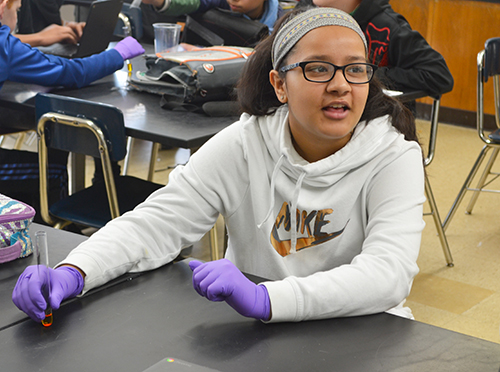
A student's test tube contains a dichromate, to which she will add water to produce a chromate (a yellow liquid.)
Thanks to the MCBees, Jefferson Middle School eighth graders learned about some basic science topics in spring 2019, such as cells and the pH scale. A couple of times a month from February through May 2019, nine members of Illinois’ School of Molecular and Cellular Biology (MCB) graduate student organization dropped by Elizabeth Wheatman’s and Sammy Yoo’s classes to lead students in some fun, STEM hands-on activities. The MCB Ph.D students (and postdocs) hoped to pique the younger students’ interest in science and possibly add some diversity to the field. Plus, the eighth graders weren’t the only ones to benefit; the scientists themselves got a lot out of the partnership. Some just enjoyed getting out of the lab for a bit, and others were reminded why they had become passionate about science in the first place.
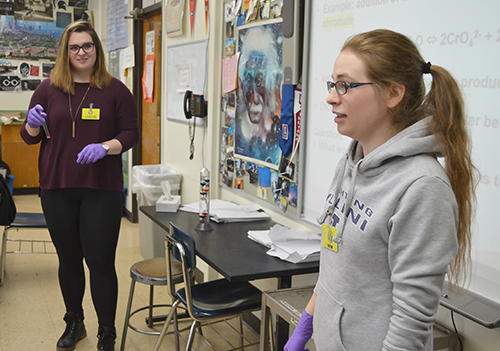 Two MCB students, Allison Boss-Kennedy and Rachel Martini, teach the eighth gaders about chemical reactions.
Two MCB students, Allison Boss-Kennedy and Rachel Martini, teach the eighth gaders about chemical reactions.Alternating between Mondays and Wednesdays, the older students took turns coming up with a science-related lesson plan for the day, which four or five members of the group helped to teach each time. Some of the toopics covered included enzymes, nutrition, the pH scale, cells, and hydrophobic and hydrophyllic molecules.
For example, in Roy Rodriguez-Carrero’s Feb 25th activity called "Acid Breath," students exhaled into a solution which they then tested using pH indicators. The idea was that since humans exhale carbon dioxide, the color of the pH indicator would change due to formation of acid.
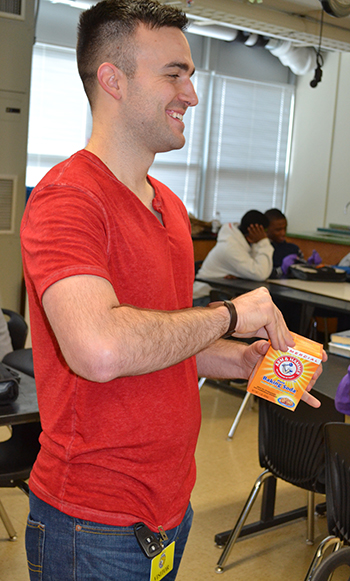
Dylan Blaha prepares to distribute baking soda, a base, to students to see what impact it wil have on their solution.
During the March 13th lesson, "Introduction to Chemical Reactions," created by Dylan Blaha, the goal was to teach the eighth graders that a chemical reaction is a process that involves rearrangement of the molecular structure of a substance. During the different hands-on activities, students learned about both single and double displacement reactions, learned to distinguish between static and dynamic chemical equilibrium, and tried to predict the effect of adding a stress to a system at equilibrium.
On March 25th, the group led the “Looking at Cells Under a Microscope” activity created by Pradeep Kumar, one of the MCBees’ outreach coordinators. Kumar wanted the younger students to understand that all living things are made up of cells, then study cells under a microscope to see their various shapes and sizes. Not only did the eighth graders see the overall cell shapes of various materials, but they identified several features. For example, while both plant and animal cells share several common features, like a nucleus and chromosomes, they also have specific characteristics, such as a cell wall, which is present in plant cells but absent in animal cells. The activity was a much-simplified version of Kumar’s research. The third-year Cell and Developmental Biology grad student works in Andrew Belmont’s lab studying how 6+ feet of human DNA is packed into a cell’s tiny nucleus.
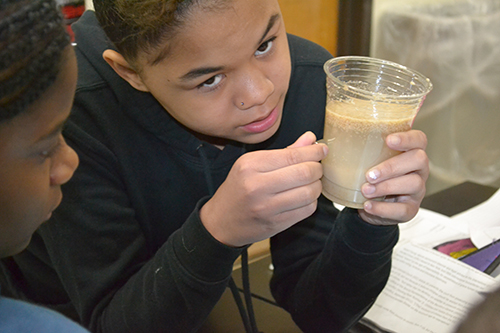
An eighth grader uses a magnet to isolate iron from pulverized Cheerios.
The goal of Surbhi Jain’s April 10th activity was to help students become more aware of nutrition in the food they eat. The idea was to help the students understand that the Cheerios they eat for breakfast are more nutritious because they've been fortified with iron. So in this activity, students first pulverized Cheerios, added water, then used a magnet to isolate the iron from the cereal. Jain says that while oats might have some iron, it wouldn't be that much were it not fortified. “So that's why a lot of food processing companies and cereal companies add all these different small nutrients through fortifying the food,” she says.
Jain explains why it’s important for kids to learn about nutrients in their food. “We eat so many different things, and we don't even know what we are putting in our bodies.” So the idea was to make kids more aware at an earlier age: “Because kids could be more prone to eating junk food, and then you have to know that that food doesn't really have anything in it of value.”

Surbhi Jain explains an activiy to the eighth graders.
While some of the activities the grad students came up with might be at least slightly related to their research, for Jain, a 5th year biochemistry graduate student under Prof. Huimin Zhao, her research is completely unrelated to the topic she chose. She works in genome editing, using a new tool called CRISPR CAS9 which might eventually be used to cure genetic diseases by making cuts in one’s genome. She explains how CAS9, the protein that can make the cut, could be used to cure someone who has, say, sickle cell disease. “This is a disease where you have a single mutation in your body. So if it tell this protein where to go, if I program it, then it can go in and specifically cut at the site of this mutation. And if I provide it with another gene which is correct, then it will be integrated with your genome.” So the idea is to take these cells out of a body, fix them with this CRISPR CAS9 gene editing, and then put them back in.
Because the process could be risky, and the tool used to create cuts in the wrong place, safeguarding this tool is very important. “So that is one of my projects,” she explains, “to figure out how to get a precise cut at the exact location you want. This is the main thing: how to make these tools as safe as possible."
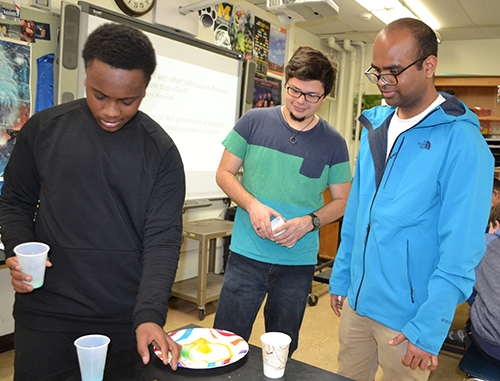
Roy Rodriguez-Carrero (center) and Pradeep Kumar (right) watch as a student does an experiment in which soap binds hydrophobic molecules.
Anshika Gupta’s April 29th activity, 'Colors on the Move,” demonstrated the interaction of soap molecules with milk. Because of soap’s ability to bind hydrophobic molecules, it’s able to bind to milk’s fat molecules, which are hydrophobic and are thus collected by the soap. This effect can be seen by the movement of the color drops in the milk. The concepts she wanted the students to take away were the differences between hydrophobic and hydrophilic molecules and that because soap has both, it’s useful for washing hands and clothes.
A 3rd year Microbiology student, Gupta works in James Imlay’s lab, where she studies the impact of oxidative stress on DNA, and DNA repair enzymes that help deal with this damage.
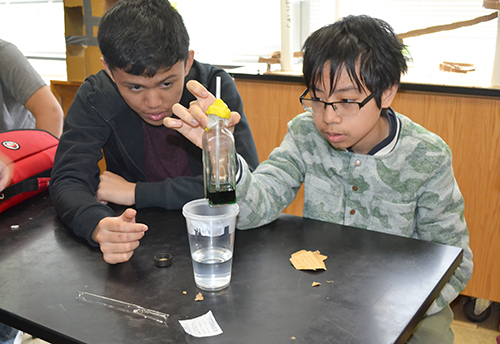
Two students prepare to place their DIY thermometer in hot water to see what impact it has.
On May the 15th, Pooja Agashe, a 4th year Microbiology student, came up with the “DIY Thermometer and pH Meter” activity. Her goal was to impress upon the students how current technologies can be inspired by basic biology.
For the thermometer, students used a mixture of food color, ethanol and water at different temperatures. As the students added hot water, the mixture expanded and was sucked up into the straw—making a thermometer. For the pH meter, students used the spice, turmeric as an indicator to tell how acidic different solutions are. This works because as acidity decreases, Turmeric changes color from yellow to red.
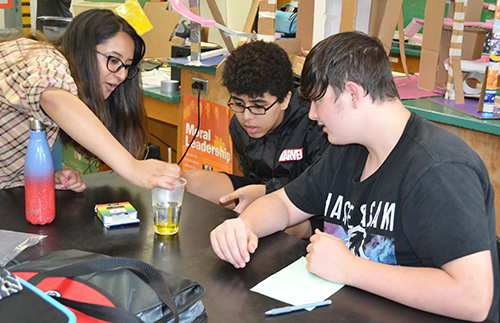
Pooja Agashe (left) works with Jefferson students to get their thermometer to work.
Agashe works in Andrei Kuzminov’s lab, studying how DNA is broken into pieces by a mixture of hydrogen peroxide and nitric oxide, both of which our immune cells produce to kill pathogens.
The MCBees helped with the outreach for various reasons. For instance, Agashe got involved because she loves teaching. “It’s very important to me to keep doing this because it allows me to interact with all these wonderful kids,” she says. “Research can be very lonely at times, and this gets me out of the lab and thinking about science in a fun, engaging way.”
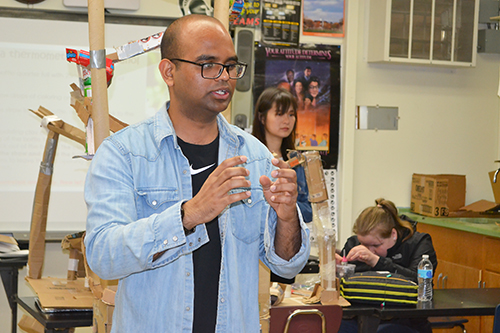
Pradeep Kumar explains a scientific principle to the students.
A first-generation college graduate, Pradeep Kumar is also passionate about science education and hopes to develop interest and curiosity in kids about science. He shares two reasons why science outreach is important. For one, he hopes to change kids’ mental images of what scientists are. He describes the typical stereotype of a scientist: “When thinking about scientists,” he reports, “people often have visions of Einstein’s crazy hair, lab coat, glasses, bubbling things in tubes and beakers. By engaging in outreach, we can convey a powerful message that scientists are also normal people.”
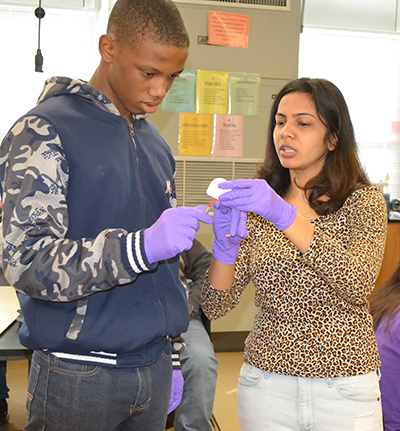
Surbhi Jain helps a student compare his bright red pH indicator to the pH scale, which indicates a strongly acidic solution.
Kumar also believes outreach is beneficial to help him and his colleagues get out of their scientific comfort zones. “As scientists, we spend a lot of time developing expertise in specific niche areas,” he reports. “By engaging in outreach activities, it makes us think about the bigger picture in relation to our studies and why people should care about our research.”
According to Surbhi Jain, one of the benefits of the MCBees outreach to the Jefferson Middle School students is to show the girls, especially, that women can be scientists.
"I think just seeing that we are women in science. I am Indian, so another American Indian girl could look at me and see that people are doing good things and that they can be a part of it. That's my main thing: representation and diversity."
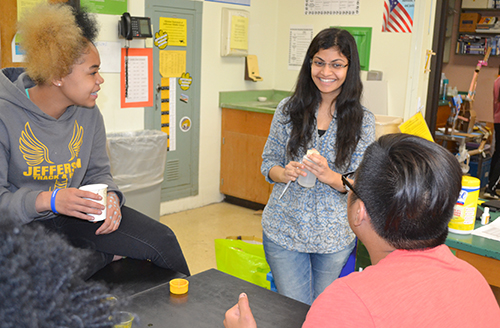
Anshika Gupta (center) interacts with Jefferson students during one of the activities.
Anshika Gupta’s goal in doing the outreach at Jefferson was to get some of the young people interested in science, and possibly recruit them into the field down the road.
“The best way to learn science is by doing science,” she explains. “And so, to encourage the kids to pursue science, it is important that they do it themselves and learn. And these outreach activities give me an opportunity to communicate my enthusiasm about science to the kids.”
Like the other MCBees, Gupta also gets a lot out of it personally. “I particularly enjoy outreach, as it gives me immense happiness to see the kids doing the experiment, being amazed at the results they see, and listening to the ideas that they have about the experiment. It brings out lots of fresh ideas which one doesn't normally think of.”
Story and photos by Elizabeth Innes, Communications Specialist, I-STEM Education Initiative.
More: Graduate STEM Outreach, 6-8 Outreach, MCBees, Jefferson Middle School, 2019
For more I-STEM articles about the MCBees, please see:
- Jefferson Middle School Students Experience Cool Hands-On Science, Courtesy of the MCBees
- At NGS’ Science Social Café, MCBees Women Serve as Role Models, Exemplify Careers in Science
- MCB’s Jeremiah Heredia: Passionate about HIV-1 Research, STEM Outreach to Underserved
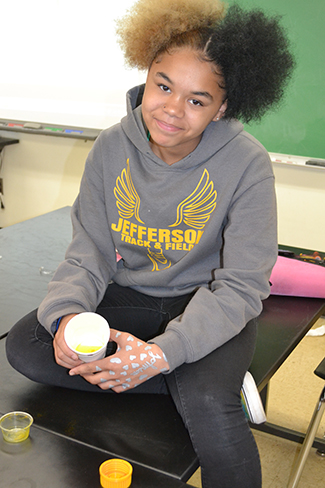
A student creates a pH indicator.
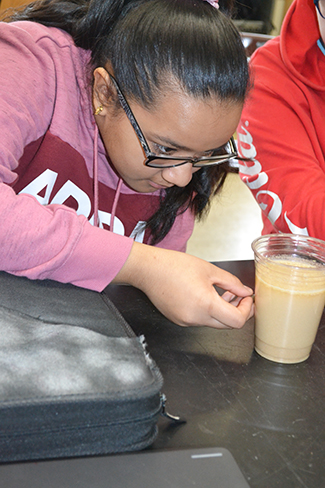
A student uses a magnet to isolate iron in her Cheerios emulsion.
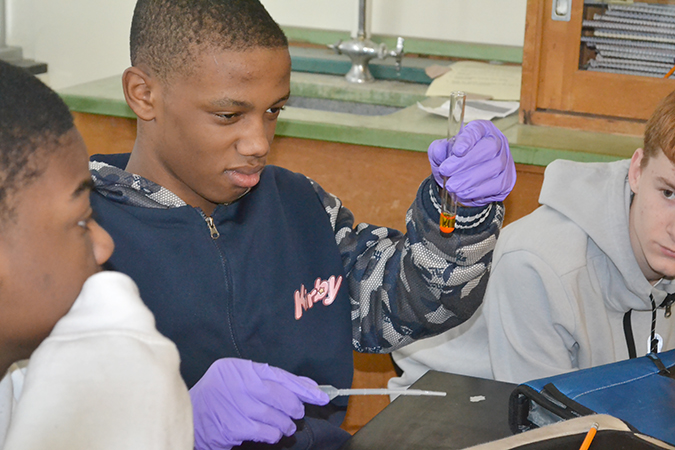
A student examines the dichromate in his test tube.













.jpg)
















